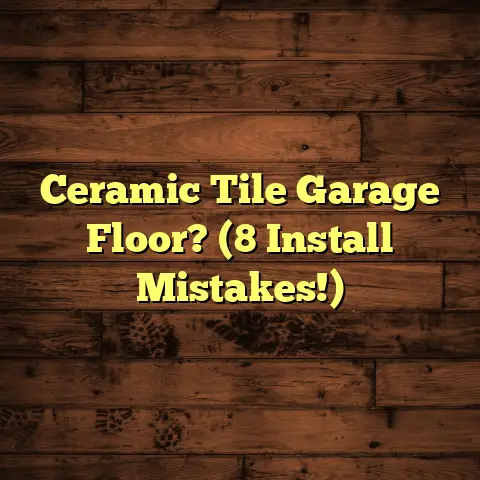Garage Epoxy Cost: What Installers Don’t Say? (2 Secrets)
Right now, garage epoxy flooring is booming.
Homeowners are turning their garages into more than just parking spots.
Think home gyms, workshops, or even entertainment areas.
And epoxy? It’s the go-to for that sleek, durable finish.
You’ve probably seen those incredible garage transformations all over Instagram and Pinterest, right?
But before you jump on the epoxy bandwagon, let’s talk about something really important: cost.
Specifically, the real cost, including the stuff some installers conveniently “forget” to mention.
I’m going to spill two big secrets that can save you serious money and headaches down the road.
Ready to dive in? Let’s do it!
Section 1: Understanding Garage Epoxy Flooring
So, what is garage epoxy flooring, exactly?
It’s not just paint, that’s for sure.
Epoxy is a thermosetting polymer. When mixed with a hardener, it creates a chemical reaction that results in a rigid, durable, and chemical-resistant surface.
Think of it as liquid plastic that hardens into a super-tough shield for your concrete floor.
Why Epoxy in Garages?
Garages take a beating. Cars, tools, dropped objects, oil spills – you name it.
Epoxy flooring offers a ton of benefits:
- Durability: Resists impacts, chemicals, and abrasions.
- Aesthetics: Creates a clean, professional look.
- Maintenance: Easy to clean and maintain.
- Safety: Can be slip-resistant with the right additives.
Aesthetic Trends
Gone are the days of plain gray epoxy.
Now, homeowners are getting creative with:
- Color Variations: Solid colors, metallic pigments, or custom blends.
- Finishes: High-gloss, matte, or textured.
- Custom Designs: Flakes, quartz, logos, and patterns.
I’ve even seen garages with epoxy floors that look like marble or granite! The possibilities are endless.
Section 2: The Cost of Garage Epoxy Flooring
Alright, let’s get down to brass tacks. How much does garage epoxy flooring actually cost?
It’s not a simple answer, because a lot of factors come into play.
Breaking Down the Costs
Here’s a general breakdown:
- Materials: Epoxy kits, primers, topcoats, flakes, etc.
- Labor: Installation, surface preparation, cleanup.
- Additional Fees: Surface repairs, moisture testing, disposal.
On average, you can expect to pay anywhere from $3 to $7 per square foot for professional epoxy installation.
I know, that’s a pretty wide range. Let’s dig deeper.
DIY vs. Professional Installation
DIY epoxy kits can seem tempting because they’re cheaper upfront.
You might find kits for $1 to $3 per square foot.
But here’s the thing: DIY epoxy is often lower quality, and installation is much harder than it looks.
Trust me, I’ve seen plenty of DIY disasters that end up costing more to fix than hiring a pro in the first place.
Professional installation ensures proper surface preparation, mixing ratios, and application techniques, leading to a longer-lasting and better-looking floor.
Regional Cost Variations
Location, location, location!
Labor rates and material costs vary significantly depending on where you live.
For example, epoxy installation in California or New York will likely be more expensive than in, say, Arkansas or Kentucky.
Local market conditions, demand, and the availability of qualified installers also play a role.
I remember one job in San Francisco where I had to pay almost double for materials compared to a similar job in Denver.
Section 3: Secret #1: Hidden Costs Installers Don’t Mention
Okay, here’s the first big secret.
Many installers don’t tell you about the hidden costs lurking beneath the surface (literally!).
These costs usually involve surface preparation.
The Importance of Surface Preparation
Epoxy needs a clean, sound, and properly prepared concrete surface to bond correctly.
If your concrete is cracked, stained, or has existing coatings, it will need extra work.
This can include:
- Surface Repairs: Filling cracks, patching holes, and repairing spalling (concrete flaking).
- Moisture Testing: Ensuring the concrete isn’t too damp, which can cause epoxy to peel.
- Grinding or Shot Blasting: Removing existing coatings, stains, and creating a profile for epoxy adhesion.
- Leveling: Addressing uneven surfaces that can affect the final look.
These steps aren’t always included in the initial quote, and they can add significant costs to your project.
I’ve seen surface repairs alone add hundreds or even thousands of dollars to a job.
The Budget Buster
These hidden costs can throw your entire budget off track.
Imagine thinking you’re going to spend $2,000 on an epoxy floor, only to find out you need an additional $1,000 in surface repairs.
That’s a 50% increase!
Real-Life Horror Stories
I’ve talked to countless homeowners who were blindsided by these hidden costs.
One homeowner in Texas told me he was quoted $2,500 for his garage epoxy, but the final bill was over $4,000 after surface repairs and moisture mitigation.
He said, “I wish I had known about these potential costs upfront. I would have budgeted differently or maybe even reconsidered the project.”
Another homeowner in Ohio said her DIY epoxy job failed miserably because she didn’t properly prepare the concrete.
She ended up hiring me to remove the failed epoxy, repair the concrete, and install a new epoxy floor.
It cost her more than if she had hired me in the first place.
Section 4: Secret #2: Long-Term Maintenance and Longevity
Here’s the second secret: Installers often downplay the long-term maintenance and lifespan of epoxy floors.
The Myth of “Maintenance-Free”
Some installers will tell you that epoxy floors are “maintenance-free.”
That’s simply not true.
While epoxy is durable, it’s not indestructible.
It can still be damaged by:
- Chemical Spills: Some chemicals can stain or damage the epoxy.
- Sharp Objects: Dropping heavy or sharp objects can chip or scratch the surface.
- UV Exposure: Sunlight can cause epoxy to fade or yellow over time.
- Hot Tires: Parking hot cars on epoxy can cause “hot tire pickup,” where the epoxy softens and sticks to the tires.
Factors Affecting Lifespan
The lifespan of your epoxy floor depends on several factors:
- Quality of Materials: Higher-quality epoxy will last longer.
- Installation Quality: Proper installation is crucial for longevity.
- Usage: Heavy traffic and abuse will shorten the lifespan.
- Maintenance: Regular cleaning and maintenance will extend the lifespan.
A properly installed and maintained epoxy floor can last for 5 to 10 years or more.
But neglect it, and you might be looking at repairs or replacement much sooner.
Realistic Expectations
Don’t expect your epoxy floor to look brand new forever.
Over time, it will likely show some wear and tear.
Scratches, scuffs, and minor stains are normal.
The key is to address these issues promptly to prevent further damage.
Long-Term Care Tips
Here are some tips for maintaining your epoxy floor:
- Regular Cleaning: Sweep or vacuum regularly to remove dirt and debris.
- Mild Detergent: Use a mild detergent and water to clean spills and stains.
- Avoid Harsh Chemicals: Don’t use harsh chemicals, solvents, or abrasive cleaners.
- Mats and Rugs: Place mats and rugs in high-traffic areas to protect the epoxy.
- Touch-Up Repairs: Address scratches and chips promptly with a touch-up kit.
Section 5: The Installation Process
Let’s walk through the typical epoxy installation process so you know what to expect.
Step-by-Step Guide
- Preparation: The concrete surface is cleaned, degreased, and repaired.
- Profiling: The surface is ground or shot blasted to create a profile for epoxy adhesion.
- Priming: A primer is applied to promote bonding and seal the concrete.
- Epoxy Application: The epoxy is mixed and applied in multiple coats.
- Decorative Flakes (Optional): Flakes are broadcast into the wet epoxy.
- Topcoat: A clear topcoat is applied to protect the epoxy and flakes.
- Curing: The epoxy is allowed to cure for the recommended time (usually 24-72 hours).
Timeframes
The entire process can take 2 to 5 days, depending on the size of the garage, the complexity of the design, and the curing time.
Be patient! Don’t rush the process, or you’ll risk compromising the quality of the floor.
Common Mistakes
Here are some common mistakes to avoid:
- Inadequate Surface Preparation: This is the biggest culprit for epoxy failures.
- Improper Mixing Ratios: Mixing the epoxy and hardener incorrectly can affect the curing process.
- Applying Epoxy Too Thinly: Applying too little epoxy can result in a weak and brittle floor.
- Applying Epoxy in Extreme Temperatures: Extreme temperatures can affect the curing process.
Hiring a skilled professional can help you avoid these mistakes and ensure a successful epoxy installation.
Section 6: Real-Life Experiences and Case Studies
Let’s hear from some homeowners who have gone through the epoxy flooring experience.
The Good, the Bad, and the Ugly
One homeowner in Colorado said his epoxy floor completely transformed his garage into a functional workshop.
He said, “The epoxy floor is so easy to clean, and it looks great. It’s the best investment I’ve made in my garage.”
Another homeowner in Florida had a less positive experience.
She said her DIY epoxy floor started peeling within a year because she didn’t properly prepare the concrete.
She ended up spending more money to have it professionally removed and replaced.
Before-and-After Photos
(Include before-and-after photos of garage epoxy transformations here)
These photos speak volumes!
They show the dramatic difference an epoxy floor can make in the appearance and functionality of a garage.
Long-Term Performance
Many homeowners report that their epoxy floors hold up well for several years with proper maintenance.
However, some have experienced fading, scratches, and stains over time.
The key is to address these issues promptly to prevent further damage and extend the lifespan of the floor.
Section 7: Final Thoughts on Garage Epoxy Cost
Alright, we’ve covered a lot of ground.
Let’s recap the key takeaways:
- Garage epoxy flooring is a popular and durable option for garages.
- The cost can range from $3 to $7 per square foot for professional installation.
- DIY epoxy kits can be cheaper upfront but often lead to problems.
- Hidden costs, such as surface preparation and moisture mitigation, can significantly increase the overall cost.
- Epoxy floors require regular maintenance to ensure longevity.
Do Your Homework
Before you jump into an epoxy flooring project, do your homework.
Get multiple quotes from reputable installers.
Ask about surface preparation, moisture testing, and long-term maintenance.
Read reviews and check references.
Don’t be afraid to ask questions!
The more informed you are, the better equipped you’ll be to make the right decision for your garage and your budget.
Make the Right Choice
Choosing the right flooring for your garage is a big decision.
By understanding the true costs and maintenance requirements of epoxy flooring, you can make an informed choice that will transform your garage into a space you’ll love for years to come.
Good luck with your project!





